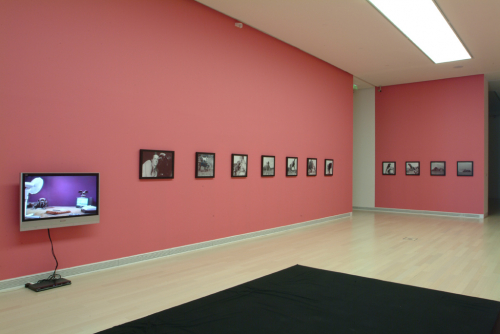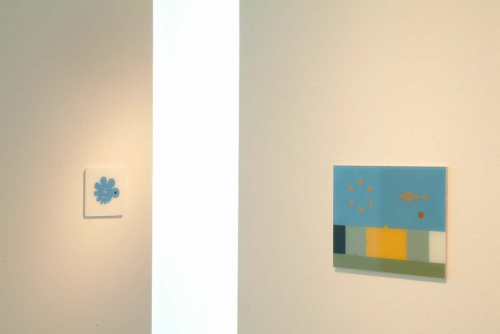
Keith Haring 15. August, 2008 – 16. November
Keith Haring, having died of AIDS at the age of 31, would be 50 years old in 2008. His anniversary is going to be celebrated with several exhibitions and events all over the world.

Keith Haring, having died of AIDS at the age of 31, would be 50 years old in 2008. His anniversary is going to be celebrated with several exhibitions and events all over the world.

Sarajevo-born French artist Braco Dimitrijević came to international attention in the 1970s with his Casual Passer-by works, which presented enlarged portrait photographs of unknown people in public places – building frontages or advertising hoardings.

Simon Starling (b.1967) is one of the most interesting figures in the contemporary international art scene, known throughout the world for his site-specific projects. His works are always preceded by thorough research in which he transforms and reinterprets existing objects.

Fluxus is well-known as an (anti-)artistic, international network with centres in the USA, Western Europe and Japan. But what about this “intermedia” art ‒ art encompassing music, actions, poetry, objects and events ‒ beyond the “Iron Curtain”?

In the middle of the 1960s, István Nádler was among the first Hungarian representatives of the neo-avant-garde movement.

Hans van der Meer: European Fields ‒ The Landscape of Lower League Football Bertien van Manen: Give me your image

The last in the series of exhibitions featuring the museum’s collection, "All That Cinema" presents the best of the motion picture works held in the Museum.

This is the first time since the initial exhibitions of the Ludwig Museum in 1991 and the Museum of Contemporary Art in 1996 that the Museum’s own collection has been put in full focus.
This is the first time since the initial exhibitions of the Ludwig Museum in 1991 and the Museum of Contemporary Art in 1996 that the Museum’s own collection has been put in full focus: some three hundred of the five hundred items it holds will be on display on the three floors of the Museum.

This is the first time since the initial exhibitions of the Ludwig Museum in 1991 and the Museum of Contemporary Art in 1996 that the Museum’s own collection has been put in full focus: some three hundred of the five hundred items it holds will be on display on the three floors of the Museum.

For this unique concert, we have also extended an invitation to young people. We asked young artists, some of who are still studying this beautiful profession, to paint their own Pictures at an Exhibition.

This exhibition is a true rarity, an installation of memoranda, marginal notes, invitations and promotional material of the famous American art critic and curator, former chairman of one of UNESCO’s foremost specialist organisations, AICA (Association Internationale des Critiques d’Art).

Katarzyna Kozyra is one of the world’s most famous contemporary Polish multi-media artists. The travelling exhibition now coming to the Ludwig Museum started out in 2003, and documents a project in two venues, Warsaw and Berlin, using the visual tools of theatre, film, pop music and opera.

STRABAG Painting Prize 2007
14 September–14 October 2007

László Fehér first came to attention in the late 1970s in the Studio exhibitions, and has been a prominent figure of Hungarian art for the last twenty-five years. After the radical social documentation of his early photorealistic period, he turned to family mythology.

Pécs-born Marcel Breuer (1902–1981) was one of the Modernist architects and furniture designers of the greatest influence in the 20th century.

Visitors to the Ludwig Museum may encounter a veritable “Chinese market” on the third floor between 26 May and 3 June 2007.

The Ludwig Museum does justice to an annual tradition by undertaking the presentation of a photographic collection that is internationally known.

The art award of high distinction as well as significant monetary sum will be awarded for the second time in 2007 to students of the art academies of Central/Eastern Europe.

The exhibition presents concepts and works (videos, installations, and photographic pieces) of young and renowned artists from Eastern Europe, focusing on the question of identity as one of the most urgent topics in a global world.

On the initiative of the French region of Pays de la Loire, within the framework of the commemoration of the 10th anniversary of economic and cultural cooperation with the Hungarian region of Lake Balaton, the Fonds régional d’art contemporain des Pays de la Loire presents a selection from its co

Ákos Birkás, who was born in 1941, is one of the emblematic figures of contemporary Hungarian art. A few years ago, he struck out in a new direction in his oeuvre, putting his earlier work into a quite new perspective.

Gábor Bódy would have turned 60 in 2006. One of the most talented film directors of the sixties and seventies, he exercised a significant influence on the mode of visual expression in visual art and photography with his experimental films and theoretical writings.

STRABAG (formerly Hungarian Asphalt) road construction company is holding its competition for young artists for the tenth time in 2006. A distinguished jury awards the prizes and the winning works will be displayed by the Ludwig Múzeum.

The Pink House is an inflatable house occupying 150 square metres of floor space, standing nine metres tall and fashioned after a Greek temple.